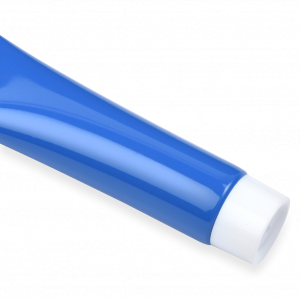For over 25 years, COMPAX has been a trusted partner in providing top-quality tubes with unparalleled decoration capabilities, helping brands like yours stand out in the market. With a wide array of tube options available, choosing the right tube material and closure for your product can be a daunting task. To assist you in making an informed decision, here’s an in-depth look at the different tube materials we offer:
Monolayer Plastic Tubes #
 Monolayer plastic tubes are crafted through the extrusion process. A cylindrical plastic material is pushed through a die with the desired diameter cross-section (e.g., 35mm) and cut to the required length. As the name suggests, monolayer tubes consist of a single layer. The choice of plastic material, such as HDPE (High-Density PE), LDPE (Low-Density PE), or LLDPE (Linear Low-Density PE), determines the tube’s flexibility. A higher percentage of HDPE in the composition results in a stiffer tube, while 100% LLDPE offers more flexibility. Monolayer tubes are a cost-effective solution when a significant barrier is not required for your product’s formula.
Monolayer plastic tubes are crafted through the extrusion process. A cylindrical plastic material is pushed through a die with the desired diameter cross-section (e.g., 35mm) and cut to the required length. As the name suggests, monolayer tubes consist of a single layer. The choice of plastic material, such as HDPE (High-Density PE), LDPE (Low-Density PE), or LLDPE (Linear Low-Density PE), determines the tube’s flexibility. A higher percentage of HDPE in the composition results in a stiffer tube, while 100% LLDPE offers more flexibility. Monolayer tubes are a cost-effective solution when a significant barrier is not required for your product’s formula.
Co-Ex Plastic Tubes #
Co-Extruded (Co-Ex) tubes follow a similar extrusion process to monolayer tubes but have multiple layers. The most common co-ex tubes feature five layers: PE-Adhesive-EVOH-Adhesive-PE. The EVOH layer significantly enhances the barrier properties of the polyethylene tube. This allows you to have a soft, flexible LDPE co-ex tube with high barrier properties. Co-ex tubes are ideal when you need to increase the barrier of HDPE to better protect your formula.
Laminated Tubes #
 Laminated tubes are constructed from flat sheets of material, including various barrier layers and even aluminum, which are rolled over and welded together. If your product requires more extensive barrier properties than a co-ex tube can provide, laminated tubes are an excellent choice. However, it’s essential to note that laminate tubes cannot be decorated at 360 degrees due to the seam.
Laminated tubes are constructed from flat sheets of material, including various barrier layers and even aluminum, which are rolled over and welded together. If your product requires more extensive barrier properties than a co-ex tube can provide, laminated tubes are an excellent choice. However, it’s essential to note that laminate tubes cannot be decorated at 360 degrees due to the seam.
Injection Molded Plastic Tubes #
Injection molded tubes are manufactured using an injection mold process. These tubes incorporate the neck and tube into a single unit and can be decorated seamlessly. Unlike extruded tubes made from polyethylene, injection molded tubes are crafted from polypropylene. Polypropylene offers higher barrier properties than HDPE, often eliminating the need for additional protective layers. You have the option to choose traditional decoration methods or explore the extensive possibilities of In-Mold Labeling (IML) for tubes. While IML offers vast decoration opportunities, it typically comes with higher price points and minimum order quantities (MOQs).
Closure Options and MOQs #
At COMPAX, we offer an extensive range of tube heads and closure options, from needlenose to airless pumps, to complement your chosen tube material. MOQs for Monolayer, Co-Ex, Laminate, or Injection Molded Tubes typically begin at 10,000 pieces, allowing you flexibility in selecting the right quantity for your specific needs.




